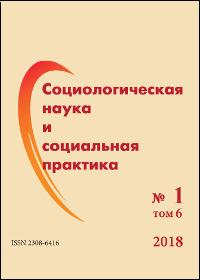Factors of Income Stratification of Russian Society: Methodology of the Analysis and Role Ascriptive Characteristics
Abstract
References
Karavay A.V. Sotsial'nyy kapital rossiyskikh rabochikh i ikh ustanovki v otnoshenii ego nakopleniya [Russian workers: social capital and capital accumulation settings]. Monitoring obshchestvennogo mneniya: ekonomicheskie i sotsial'nye peremeny. 2016. № 3. P. 1–15 (In Russ.).
Khakhulina L.A., Tuchek M. Raspredelenie dokhodov: bednye i bogatye v postsotsialisticheskikh obshchestvakh (nekotorye rezul'taty sravnitel'nogo analiza) [Distribution of income: the poor and the rich in post-socialist societies (some results of the comparative analysis)]. Monitoring obshchestvennogo mneniya: ekonomicheskie i sotsial'nye peremeny. 1995. №. 1. P. 18–22 (In Russ.).
Kozyreva P.M. Resursy i praktiki sotsial'no-ekonomicheskoy adaptatsii naseleniya Rossii [Resources and practice of social and economic adaptation of the population of Russia]. M.: Novyy khronograf publ., 2013. 328 p. (In Russ.).
Lezhnina Yu.P. Sem'ya dlya srednedokhodnykh sloev naseleniya: tyl ili risk? [Middle-income families in Russia: comparing domestic support and exposure to risk]. Zhurnal issledovaniy sotsial'noy politiki. 2017. Vol. 15. № 3. P. 435–452 (In Russ.).
Lezhnina Yu. P. Sotsial'no-demograficheskie faktory, opredelyayushchie risk bednosti i maloobespechennosti [The social demographic factors defining risk of poverty and low-sufficiency]. Sotsiologicheskie issledovaniya. 2010. № 3. P. 36–45 (In Russ.).
Loginov D.M., Avraamova E.M. Sotsial'no-ekonomicheskaya adaptatsiya: resursy i vozmozhnosti [Social and economic adaptation: resources and opportunities]. Obshchestvennye nauki i sovremennost'. 2002. № 5. P. 24–34 (In Russ.).
Marno V. Modeli s mnozhestvennym otklikom [Models with a multiple response]. Putevoditel' po sovremennoy ekonometrike. Per. s angl. V.A. Bannikova. Ed. by S.A. Ayvazyana. M.: Nauchnaya kniga publ., 2008. P. 316–329 (In Russ.).
Ovcharova L.N. Teoreticheskie i prakticheskie podkhody k otsenke urovnya, profilya i faktorov bednosti: rossiyskiy i mezhdunarodnyy opyt [Theoretical and practical approaches to assessment of level, profile and factors of poverty: Russian and international experience]. M.: M-Studio publ., 2009. 268 p. (In Russ.).
Ovcharova L.N., Popova D.O, Rudberg A.M. Dekompozitsiya faktorov neravenstva dokhodov v sovremennoy Rossii [Decomposition of Income Inequality in Contemporary Russia]. Zhurnal novoy ekonomicheskoy assotsiatsii. 2016. № 3 (31). P. 170–186 (In Russ.).
Popova D.O. Dinamika faktorov neravenstva v Rossii na mikrourovne v period 1994–2013 gg.: regressionnyy analiz [Dynamics of factors of inequality in Russia at the microlevel during 1994-2013: regression analysis]. Doklad na XVI Aprel'skoy mezhdunarodnoy nauchnoy konferentsii «Modernizatsiya ekonomiki i obshchestva». M.: NIU VShE publ., 2015 (In Russ.).
Radaev V.V. Ponyatie kapitala, formy kapitalov i ikh konvertatsiya [Concept of the capital, form of the capitals and their converting]. Ekonomicheskaya sotsiologiya. 2002. T. 3. № 4. P. 20–32 (In Russ.).
Rossiya v tsifrakh. 2016: Krat.stat.sb [Russia in figures. 2016: Short statistical collection]. Rosstat–M., 2016, 543 p.
Sivukha S.V., Titma M. Kh. Sotsial'nye determinanty samootsenki uspekha [Social determinants of a self-assessment of success]. Sotsial'noe rassloenie vozrastnoy kogorty. Ed. by M.Kh. Titma. M.: In-t sotsiologii RAN publ., 1997. P. 250–274 (In Russ.).
Slobodenyuk E.D. Faktory absolyutnoy i sub"ektivnoy bednosti v sovremennoy Rossii [Factors of absolute and subjective poverty in modern Russia]. Vestnik obshchestvennogo mneniya. Dannye. Analiz. Diskussii. 2016. № 3–4. P. 82–92 (In Russ.).
Slobodenyuk E. D. Posledstviya krizisa 2015 g.: obednenie ili prekarizatsiya? [Consequences of the 2015 crisis: slipping into poverty or precarity?]. Zhurnal issledovaniy sotsial'noy politiki. 2017. № 2. P. 183–200 (In Russ.).
Tereshchenko O.V., Kurilovich N.V., Knjazeva E.I. Mnogomernyy statisticheskiy analiz dannykh v sotsial'nykh naukakh: ucheb. posobie [The multidimensional statistical analysis of data in social sciences: study guide]. Minsk: BGU publ., 2012. 239 p. (In Russ.).
Tereshchenko O.V., Titma M.Kh. Differentsiatsiya dokhodov v kogorte tridtsatiletnikh [Differentiation of income in a cohort of thirty-year-old]. Sotsiologicheskiy zhurnal. 1996. № 3–4. P. 196–217 (In Russ.).
Tikhonova N.E. Sotsial'naya struktura Rossii: teorii i real'nost' [Social structure of Russia: theories and reality]. M.: Novyy khronograf: In‑t sotsiologii RAN publ., 2014. 408 p. (In Russ.).
Tikhonova N.E. Stratifikatsiya po dokhodam v Rossii na fone drugikh stran [Income Stratification in Russia in Comparison with Other Countries]. Obshchestvennye nauki i sovremennost'. 2017b. № 3. P. 26–41 (In Russ.).
Tikhonova N.E. Stratifikatsiya po dokhodu v Rossii: spetsifika modeli i vektor izmeneniy [Income Stratification in Russia: Model Specifics and Vector of Dynamics]. Obshchestvennye nauki i sovremennost'. 2017a. № 2. P. 23–35 (In Russ.).
Anikin V.A., Lezhnina Y.P., Mareeva S.V., Slobodenyuk E.D., Tikhonovа N.Е. Income stratification: Key approaches and their application to Russia. Higher School of Economics Research Paper No. WP BRP 02/PSP/2016. Moscow: National Research University Higher School of Economics, 2016.
Bourdieu P., Passeron J.C. Reproduction in education, society and culture. London: Sage, 1990. Vol. 4. 236 p.
Eisenhauer J.G. The rich, the poor, and the middle class: Thresholds and intensity indices. Research in Economics. 2011. Vol. 65. № 4. P. 294–304.
Ravallion M. The developing world’s bulging (but vulnerable) middle class. World development. 2010. Vol. 38(4). P. 445–454.








 Publisher: Federal Center of Theoretical and Applied Sociology of the Russian Academy of Sciences (FCTAS RAS)
Publisher: Federal Center of Theoretical and Applied Sociology of the Russian Academy of Sciences (FCTAS RAS)